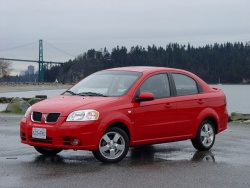 2007 Pontiac Wave SE sedan. Click image to enlarge |
|
Related articles on Autos
Manufacturer’s web site
|
By Chris Chase
Korean brand Daewoo hasn’t sold cars under its own banner in North America since 2002, when the company went out of business on this continent after just four years of sales. It would make its return in 2004 under the ownership of General Motors and Suzuki (GM-DAT), which began selling a number of “rebadged” Daewoo models in the hopes of attracting import shoppers looking for a good deal.
One of those “good deal” cars was the Pontiac Wave, a subcompact based on the Daewoo Kalos introduced as a Canada-only model in 2005, a year later than the near-twin Chevrolet Aveo. Sold as a four-door hatchback (Wave5) or sedan, the Wave was powered by a 1.6-litre four-cylinder engine making 103 horsepower; the standard transmission choice was a five-speed manual, and a four-speed automatic was the option.
In 2007, sedan versions of the Aveo and Wave got new styling and a tweaked suspension, plus some changes to the standard features and options lists. Hatchback models wouldn’t get the updated styling until 2009, when both sedans and hatches also got a new, more efficient engine and were renamed the G3 Wave.
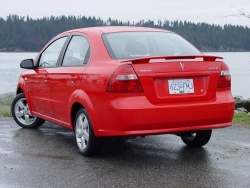 2007 Pontiac Wave SE sedan. Click image to enlarge |
The G3 Wave was discontinued, along with the rest of the Pontiac line, after the 2009 model year, though a few 2010 models did make it out of showrooms.
Fuel consumption, while decent in the grand scheme, was a letdown compared to other small cars. The 2005 Wave’s ratings of 8.8/6.1 L/100 km (city/highway, with manual transmission) were more on par with many compact cars, rather than other subcompacts; ratings for cars with the optional automatic transmission were even a bit higher. It wasn’t until 2009, with the more efficient motor, that ratings moved closer (though still not close enough) to average for the class, at 7.9/5.7 with the manual transmission and 8.2/5.8 with the automatic.
Consumer Reports calls the Wave’s reliability so far “much worse than average,” citing a number of trouble spots and naming the car to its “worst of the worst” list of used vehicles to avoid.
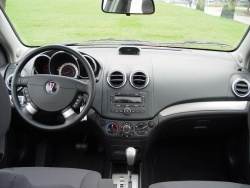 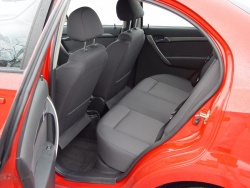 2007 Pontiac Wave SE sedan. Click image to enlarge |
Two problems I was able to find evidence of online had to do with the older 1.6-litre engine’s valve-train. One was for valves that don’t “seat” properly, meaning that they don’t close completely, which prevents the engine from generating the compression it needs to run properly. This was covered, at least in the U.S., by a technical service bulletin issued by GM. Read about this issue in a thread at Topix.com.
Next up, is the issue of frequent timing belt failures, in some cases, before the manufacturer’s recommended replacement interval of 60,000 miles (about 96,000 km).
This Topix.com thread about hard-to-start Aveos could be linked to Consumer Reports’ assertion that fuel system troubles plague these cars regardless of model year.
Here’s a thread about poor performance in cold weather. It appears that either the older 1.6-litre engine’s throttle body, or the electronic engine control module – or both – dislike working in sub-zero temperatures. Three of the four recalls that apply to the first-generation Aveo and its clones deal with throttle body icing in cold weather.
See this thread at AveoForum.com for information about a suspension rattle that appears to be what Consumer Reports is referencing in noting a problem with this car’s shocks and struts.
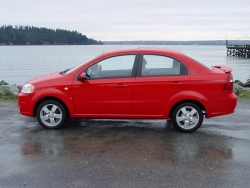 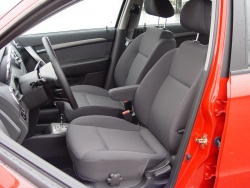 2007 Pontiac Wave SE sedan. Click image to enlarge |
A thermostat problem is linked to a plastic thermostat housing that cracks and causes coolant leaks, leading to overheating and, in some cases, damaged engines.
In cars with the automatic transmission, it’s common for the shifter to become stuck in “Park,” thanks to a brake pedal shift interlock that fails.
A non-functioning climate control blower motor is probably caused by something as simple as a blown relay or resistor, electrical components that are relatively inexpensive and, assuming you know where the broken bit in question is located, not difficult to replace yourself.
Interior build quality is also suspect, with many complaints of squeaks and rattles, wind noise and poor-fitting interior trim pieces.
The Insurance Institute for Highway Safety (IIHS) didn’t crash test the Wave (it wasn’t sold in the U.S.) but tested the redesigned 2007 Aveo. That car scored an “acceptable” rating in frontal offset testing, and a “marginal” rating in side impact protection. The poor latter rating was given because of a high likelihood of pelvic injuries to the driver, head injuries to rear-seat passengers and overall poor performance of the car’s safety cage. Note that this U.S.-spec car had standard front-seat side airbags, which were optional in Canada starting with 2006 models.
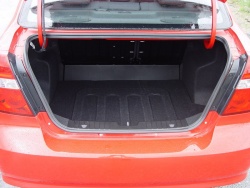 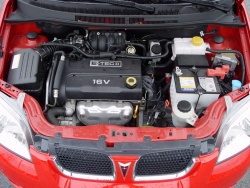 2007 Pontiac Wave SE sedan. Click image to enlarge |
From the U.S. National Highway Traffic Safety Administration (NHTSA), the 2004 Aveo sedan earned five stars in frontal impact protection, but only three stars in side impact tests, thanks to the same high risk of pelvic injury noted by the IIHS. The redesigned 2007 sedan scored five and four stars (driver and passenger) in the NHTSA’s frontal crash test, and front-seat side airbags scored an improved four stars in front seat occupant protection.
According to Canadian Black Book, used Wave values range from a low of $5,750 for a 2005 sedan to a high of $12,075 for a 2010 Wave SE. The only versions of these cars worth buying are 2009 and new models with the more efficient engine; a base 2009 model with air conditioning and manual transmission is worth $9,925, down from an MSRP of $13,270, indicating a high rate of depreciation.
Ultimately, I wouldn’t recommend the Wave. It may be cheap to buy, but its poor reliability and higher-than-expected fuel consumption are big reasons to look elsewhere for a similarly-priced car (Hyundai Accent/Kia Rio) or spend a little more on a Honda Fit or Toyota Yaris, or even a similarly-priced compact car. If you have to have a Wave, choose a 2009 or newer model, for the more efficient engine. If you do, choose carefully, avoiding any car that doesn’t come with detailed service records or doesn’t pass muster with a trusted mechanic.
|
Pricing
Black Book Pricing (avg. retail) December, 2010:
Online resources
Recalls
2004-2005: On certain vehicles, the engine throttle may stick in the open position due to throttle body icing in temperatures near or below -20 degrees Celsius. If the throttle sticks open while the vehicle is moving, a crash could occur without prior warning. The vehicle may experience this condition even if one or both of the previous two campaign services have been performed. See recall 2005235 (GM 05521) & 2006239 (GM 06515). Correction: Dealers will replace the PCV and throttle body systems.Transport Canada Recall Number: 2006266; Units affected: 4,169 2007: Certain vehicles equipped with a 1.6L engine may develop a fuel leak as a result of fuel line rupture in a frontal crash test. In addition, the crash damage caused four short circuits in the fuse block, the combination of which allowed the fuel pump to continue running, allowing fuel to be pumped onto the ground. Fuel leakage in the presence of an ignition source could result in a fire. Correction: Dealers will replace the fuse block and install a redesigned section of fuel line. Transport Canada Recall Number: 2006239; Units affected: 36,678 2004-2005: On certain vehicles, the engine throttle may stick in the open position due to throttle body icing in temperatures near or below -20 degrees Celsius. If the throttle sticks open while the vehicle is moving, a crash could result without prior warning. Correction: Dealers will repair the PCV system update kit previously installed in recall 2005235 (GM 05521). Transport Canada Recall Number: 2005235; Units affected: 36,678 2004-2005: Certain vehicles may experience throttle body icing in conditions where temperatures are near or below -20 degrees Celsius. Vehicle with this condition could have the throttle stick open after a cold soak or they can experience a frozen throttle while driving. Correction: Dealers will install new parts that integrate with the coolant system to heat the PCV lines and avoid PCV freezing.
Crash test results
Used vehicle prices vary depending on factors such as general condition, odometer reading, usage history and options fitted. Always have a used vehicle checked by an experienced auto technician before you buy. For information on recalls, see Transport Canada’s web-site, www.tc.gc.ca, or the U.S. National Highway Transportation Administration (NHTSA)web-site, www.nhtsa.dot.gov. For information on vehicle service bulletins issued by the manufacturer, visit www.nhtsa.dot.gov. For information on consumer complaints about specific models, see www.lemonaidcars.com. |







 Follow Autos on Twitter
Follow Autos on Twitter



